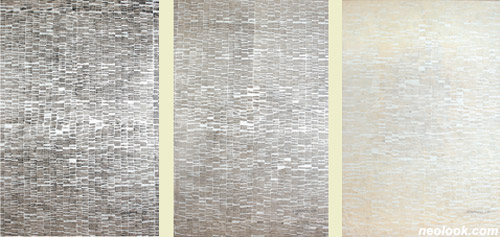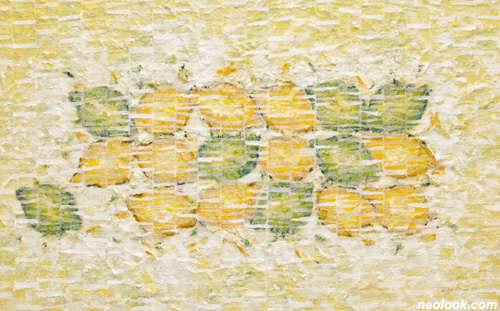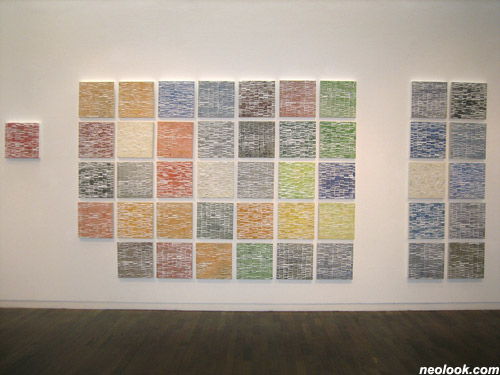- ● homepage
- ● archives
- ● restoration
- ● books
- ● big banners
- ● post board
- ■ neo's search
- ■ about us
- ■ 게재방법 안내
- 개인정보처리방침

- [email protected]
- Tel. 02_335_7922
- Fax. 02_335_7929
- 10:00am~04:30pm
- 월요일~금요일
- 3/3(월) 대체공휴일

색...명상전
신소연展 / SHINSOYEUN / 辛所姸 / painting 2009_1016 ▶ 2009_1115

- 신소연_Meditation 명상-춘,하,추,동_캔버스에 한지, 혼합재료_각 193.3×130.3cm_2009
2009_1016 ▶ 2009_1027 초대일시_2009_1016_금요일_05:00pm 관람시간 / 10:00am~07:00pm / 공휴일_11:00am~07:00pm
메이준 갤러리 GALLERY MAYJUNE 서울 강남구 신사동 550-1번지 Tel. +82.2.543.5037 blog.naver.com/mayjunart
2009_1110 ▶ 2009_1115 초대일시_2009_1109_월요일_05:00pm 한국미술의 빛 초대展 관람시간 / 11:00am~08:00pm
예술의전당 한가람미술관 HANGARAM ART MUSEUM 서울 서초구 서초동 700번지 Tel. +82.2.580.1519 www.sac.or.kr
신소연-그것을 할 뿐! ● 작가는 화면에 다양한 재료를 구사해 질감을 지닌 형상을 올려놓았다. 그 이미지는 일상에서 받은 인상, 감정의 상태나 구체적인 그릇의 형상들이다. 자연 풍경이나 꽃에서 연유하는 단촐한 이미지와 차와 연관된 다기와 그릇 등이다. 아울러 사계절의 변화, 자연의 순환과 흐름 등의 변화를 색채로 표상하고 있다. 그 대상은 결국 작가의 명상적, 관조적 소재, 대상들인 셈이다. 변화하는 자연의 모습을 관조하고 생각에 잠기는 것, 차를 마시면서 찻잔을 들여다보는 일, 한 송이 꽃을 통해 우주자연의 본질을 헤아리는 일이란 사실 동양회화, 예술의 오랜 전통이다. ● 그려진 화면에 올려진 한지는 마치 '발'을 드리운 것 마냥 자리했다.

- 신소연_MONO-Meditation_캔버스에 한지, 혼합재료_각 193.3×130.3cm_2007
틈 사이로 바탕 면이 떠오르기도 하고 콜라주 자체가 구체적인 형상을 만들어 보인다. 몇 겹의 화면이자 이중의 이미지가 동시에 진동한다. 혼합재료로 이루어진 바탕면의 질감과 한지의 물성이 겹쳐지면서 다분히 촉각적이자 저부조의 화면을 만들어 보인다. 한지란 재료는 그림이 그려지는 바탕이 되기도 하지만 탈평면을 충족시키는 수단이 되기도 한다. 동시에 한지 자체가 지닌 투명한 색상과 은은한 빛과 미세한 떨림, 그리고 표면에 까칠하게 일어선 돌기가 자아내는 느낌은 조금은 아련하고 침잠된 분위기를 연출한다. 작가는 이를 통해 다분히 명상적인 분위기를 강조하고 싶어한다.

- 신소연_Meditation 명상_캔버스에 한지, 혼합재료_각 120×120cm_2008
사각형의 꼴들이 사각형의 공간을 채워나가면서 화면 안에 무수한 화면/공간을 만들어내고 있다. 하나이면서도 무한한 화면이다. 무한하면서도 결국 하나인 화면이다. 셀 수 없는 그 작은 면들은 그만큼의 시간과 공간을 증거하면서 무한히 지속되어 나간다. 한 마음과 또 한 마음, 다음 한 마음이 연속된다. 이 생각과 저 생각, 또 다른 생각이 줄을 잇다 보면 이내 그 생각이란 것 자체가 슬그머니 흩어진다. 그런가하면 마치 바람결이나 물살처럼 혹은 빛의 파장이나 선율처럼 흐른다. 옆으로 리듬감을 가지면서 이어져나가는 선들이, 한지의 단면들이 선을 이루고 아련하게 형태를 떠올려준다. 이미지였다가 종이라는 물성이었다가 다시 이미지와 물질 그 사이를 넘나든다.

- 신소연_Meditation 명상_캔버스에 한지, 혼합재료_130.3×322.6cm_2008

- 신소연_Meditation 명상_캔버스에 한지, 혼합재료_42×127cm_2008
주어진 화면/종이를 다시 한지로 덮어나간다는 것은 그린 것을 애써 지우면서 다시 표현하는 다분히 모순적인 행위이다. 아울러 그것은 종이의 단면을 새로운 종이로 대체하고 환생하는 일이다. 마치 허물을 벗듯이, 그리고 새로운 피부를 성형하듯이 무슨 의식과도 같이 한지를 붙여나간다. 작은 한지를 일정한 간격으로, 혹은 다양한 차이를 지닌 꼴로 하나씩 붙여나가는 것은 시간을 헤아리거나 그 시간을 무화시켜 나가는 일이기도 하다. 무수한 반복이란 결국 동일한 일을 통해서 시간의 차이를 지워나가는 것은 아닐까? ● 그렇게 한지를 정성껏 붙이고 시간을 지우고, 이기고 결국은 의식적이고 의도적이며 목적론적인 일을 순간 망실시키려는 의도를 내포하는 것이라고 볼 수 있을 것이다. 다분히 명상적이며 내면으로 침잠하는 시간을 체득하는 것이기도 하다는 생각이다. 작가의 말에 의하면 이른바 선적인 경지를 체득하고자 하는 의식과도 같은 일이라는 것이다. 그리고 이것이 작가가 작업행위를 하는 주된 목적이기도 하다.

- 신소연_Meditation 명상_캔버스에 한지, 혼합재료_72.3×116.5cm_2007
선禪이란 고요히 마음을 가라앉히고 생각하는 것이다. 외부로 향해 있는 자신의 몸과 마음을 내부로 수렴하는 일이다. 자기 안의 광활한 공간으로 모든 것을 응축시키는 것, 그러기 위해 명상을 한다. 명상이란 대뇌 신피질의 활동이 정지했을 때 보이기 시작하는 것이며 낡은 피질이 깨어나도록 하는 가장 확실한 방법인 호흡법에 의존하는 행위를 일컫는다. 그런가하면 불교에서는 마음이 움직이지 않을 때, 생각이 끊어질 때 모든 것이 아름답다고 한다. 아름다움은 바로 그러한 순간에 몸을 내밀고 나타난다. 왜냐하면 모든 것이 있는 그대로 진리이기 때문이다. 그러니까 진정한 아름다움은 '움직이지 않은 마음'에서 오는 것이다. 이를 흔히 삼매(Samadhi)라고 부른다. 감정이나 외부의 조건은 항상 일정하지 않아서 언제나 변하기 마련이다. 그때마다 중심을 잃어버리는 것이다. 따라서 가장 중요한 것은 순간순간 움직이지 않는, 흔들리지 않는 마음을 갖는 것이라고 불가에서는 말한다. 무엇을 하든 다만 '그것을 할 뿐'이다. 작가는 다만 종이를 반복해서 붙여나갈 뿐이다. 네모난 형상을 비우고 채우는 것을 무한히 반복할 뿐이다. 칠하고 덮고 지우고 가리는 일을 마냥 하염없이 반복한다. 그것은 자신의 번잡한 생각을 끊는 일이자 무심한 행위 속에서, 단조로워 보이는 콜라쥬의 집적 안에서 모종의 정신적 충일을 찾는 일이기도 하다. 또는 재료와 몸의 수행을 관조함으로써 어떤 순간의 황홀을 경험하고자 하는 일이기도 하다. 그럴 것이다. ■ 박영택

- 신소연_Meditation 명상_캔버스에 한지, 혼합재료_각 42×42cm_2007
Soyeun Shin - Nothing but just doing it! ● This artist places a shape with texture by making full use of a variety of materials on the screen. Its image comes from the impressions, states of feelings, or shapes of particular vessels she captures in every day lives, or from the scenery of nature, simple images of flowers, tea sets, vessels and the like. In addition, the changes of four seasons, and the circulation and flow of nature are presented in colors. These objects are, after all, an intention of the artist's meditative, contemplative matters and subjects. Contemplating and being lost in the changing nature, looking into the teacup as drinking tea, and imagining the nature of the universe through a flower are, in fact, a long tradition of the oriental painting and art. ● The hanji pieces put upon the pictured screen is positioned right at their place as if a 'bamboo blind' was being hung down. Sometimes the face of the background appears between the gaps and sometimes the collage itself shows a particular shape. Some layers of screen and double images vibrate at the same time. The texture of the background made out of mixed materials and the properties of hanji overlap and turn into a screen touching and with low relief. Hanji can be a material used as the background on which drawing is done but it also can work to satisfy the non-surface. At the same time, its transparent texture/color, dim tint, delicate vibration, and raising that stick out on the surface give a somewhat vague and calm ambience. The artist is making an attempt to stress this very meditative atmosphere. ● Square shapes fill up the square space, making countless screen/room on the screen. It is just one screen yet is also boundless. It is infinite but is eventually one. These small, uncountable surfaces testify time and space as much and continue on endlessly. There comes a heart after another heart after another heart. A thought and another thought come up and, soon, they scatter away. Yet they run like the wind or the water, or the wave of light or the melody. Lines that go on and on with rhythm aside become a part of the hanji and make some shape appear dimly. It is an image and sometimes it is a material and then again, it goes and comes as either one. Covering the screen/paper given over again is such a contradictory action bothering to clear off and start working again. It is also a task of replacing the slice of the surface with a new one and reviving it. Like casting off skin or grafting a new piece of skin, hanji is being attached as some kind of ceremony. Putting small pieces of hanji at particular intervals or in ways with different shapes one after another is feeling time or scattering it away. Wouldn't limitless repetition be something like eliminating the time gap by doing the same thing? ● It could imply that it intends to sticking pieces of hanji elaborately, forgetting time and winning and eventually losing all conscious, intentional, purpose-driven works. It is also thought to be greatly meditative and realizing time of calmness inside. As the artist mentioned, it is like a ritual for reaching the state of Zen. And this actually is the main purpose of the artist's working on these things. Zen is about calming one's mind down at quiet and ponder. It is to turn one's body and mind that face outward to inward. It is to condense all into one's tremendous room inside, thus one meditates. Meditation begins when the activities of the cerebrum's neocortex stop and is an action of one's relying on breathing method which is the most certain way to make the old cortex wake up. On the other hand, in Buddhism, it says that all is beautiful when one's mind does not move and one's thoughts stop. Beauty comes up and appears at such moments because all is truth as it is. In other words, the true beauty comes from 'a heart that does not move.' This is what it is called 'Samadhi'. Feelings and surroundings are not consistent and change all the time. Whenever that happens, one loses his/her center. Thus, Buddhism says what is most important is to have a heart that does not move and change at all times. No matter what one does, 'he/she just does it.' The artist does nothing but putting pieces of paper over and over again. She repeatedly empties and fills up the square shape. She continues on painting, covering, clearing off and hiding endlessly. That is to separate oneself from his/her confused thoughts and to discover some sort of mental fullness inside absentminded deeds and collection of collage that looks monotonous. It can also be something experiencing raptures of some moments by contemplating materials or one's ascetic exercises. It sure will be. ■ Young Taek Park
Vol.20091010j | 신소연展 / SHINSOYEUN / 辛所姸 / painting
